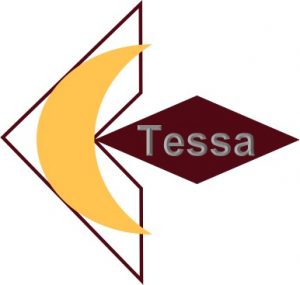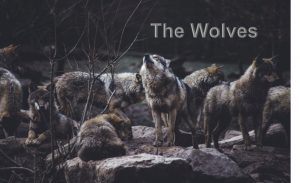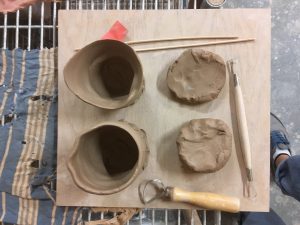For our group inquiry, Denee, Dane, Jessica, and I looked at using Apps in Outdoor Education.
Here is a screencast of our slides! Feel free to pause and look at the slides as you go!
Tessa Webb
For our group inquiry, Denee, Dane, Jessica, and I looked at using Apps in Outdoor Education.
Here is a screencast of our slides! Feel free to pause and look at the slides as you go!
The Great Pottery Throwdown is a BBC show that brings home potters from all over England to Stoke-On-Trent to compete to be top potter.
The show has been a really interesting resource for me as a new potter, as watching other people make pottery really helps with my ability as a new potter, being a visual learner as I am.
The entire first season can be watched on youtube.
I also have found a book at the library that the BBC made that goes very in depth into the history of pottery. Looking at the history of pottery would be a really interesting lens to look at human history, culture, and art. So many civilizations made ceramics. Some of the only information we have about ancient civilizations has come from finding fragments of clay pottery. If students made their own pottery and learning about the history of pottery they would feel a much greater connection to history and the richness of pottery in this way.

Keiro’s presentation – stop-go animation
stop motion (can be downloaded)
used imovie to fade into the graphic
Photo shop
Pros
Cons
Things to watch for
REsources
Google Geographic Products
Google Maps
Google Earth
Lesson Ideas
Lessons – My Maps
Privacy
cartography has nationalism built into it. Originally the way that countries were delineated.
Digital Literacy
Information Literacy
Ethical use
Understanding digital footprint
Protecting yourself online
Handling digital communication – cyberbullying
Pros & Cons
Risks
Strategies, Tips, and Best Practice
Parents and Dig Lit
Sex, sexuality and the digital world
House hippo – media smarts
On Monday, October 21 our ED 336 class went to Rebecca Bathurst-Hunt’s class to have a look at her classroom set-up and speak with her about how she implements inquiry learning into her public school classroom. Rebecca Bathhurst-Hunt and Trevor Mckenzie co-authored a book in 2018 titled Inquiry Mindset, a book designed to help teachers encourage “dreams, wonders, and curiosities in young learners”.

I was unfortunately unable to attend the classroom tour but have been working my way through her website and the multitude of other resources that have been provided by my fellow classmates and Michael, who recorded the audio of her talk and has posted it on our classroom website!
I am so inspired by Rebecca and her implementation of Inquiry based learning into her classroom practice.
Jesse Miller Recap
The use of information that technology users provide is often used for another purpose.
Important to remember that technology is embedded in our colonial, patriarchal, capitalist society and to use with caution.
Pacific School of Innovation and Inquiry Recap
I wonder if having a deep dive into Inquiry before we do an inquiry would be helpful? A very useful question posed by Katrina
Inquiry definition – in the reading, first time seen, as people who are all grown in a scholastic environment of tests, assignments, products, and grades this is really uncomfortable.
Book recommendation
Inquiry can be a meaningful way of incorporating Indigenous People’s Principles into learning.
Some words we used to describe the students at PSII were:
empowerment, eloquence, courage, enthusiasm, inventiveness, variety of skills, depth of knowledge
Rebecca Bathhurst-Hunt
Using Inquiry in the classroom – Great ideas start with a Question, Wonderwall
Trello
Trello is a collaboration tool that organizes projects into boards.
App on phone
Good for keeping inquiries or ideas organized.
Screencastify
Notion – similar options
Graphics
Pixels – dots
Vectors – how computer stores information, can change size, has clear crisp lines. mathematically based, so just grows as size increased or decreased.
Graphic creation options: browser based – easy access for students/learners and often free or open source.
GIMP – often used, tries to replicate photoshop, but just slightly more annoying
Pixlr – right in browser.
Powerpoint


Apps
Screenshots
Prisma – filters
Mirror Lab
Comica – turn photos into comic strips
https://bryanmmathers.com/ – Visual Thinkery
https://remixer.visualthinkery.com/
On October 11, my ED 336 class went to the Pacific School for Innovation and Inquiry (also known as PSII, pronounced “sigh) to learn about Inquiry based learning.
This school, PSII, is, in my humble and professional opinion, so excellent and effective.
Inquiry is a beautiful process of learning that motivates students, provides an exceptional foundation for future learning, and prepares these young minds for the high-level executive functioning that is required to be successful in this modern world.
The students at this school start their year off by learning how to ask meaningful questions and spend their first week coming up with questions and then narrowing those questions down to topics that interest them and areas they would like to explore. Once this is done, students are provided tools, support, and time to delve deep into their inquiry projects.
Inquiry is unique in that it is a learning style that emphasizes the process of learning, as opposed to the creation of an end result, which is the goal of project based learning or most traditional schooling models. If a students inquiry no longer interests them or they have learned a satisfactory amount they can let an line of inquiry be dropped. This often happens and is seen as part of the inquiry process.
The unique and authentic learning that occurs at PSII is inspiring. I hope that this model becomes more common place in our learning world.
I went back to the pottery studio recently, and oh boy, did I learn some new things!
I got there and the first thing I had to do was trim my pieces from the previous throwing session! Which was news to me, but I learned it is a very important step in the process of making pots.
Trimming is the process of removing the excess clay from the bottom of your piece. This happens after your pieces have dried to a leathery texture. This step is completed on the pottery wheel and requires a few key tools and materials. Here is a picture of my pieces pre-trimming with the tools I used to trim them.

It really helps when your pieces are smooth on the top, but mine were not. This made attaching them to the wheel a bit more difficult. Pieces are attached using extra, wet clay to hold the pieces in place. The wheel is then turned on and the tools are used to remove the excess clay from the bottom of the pieces. This clay naturally builds up when you are forming the pieces on the pottery wheel. Bottoms can be trimmed to be flat or have fancy shapes. This process is also important for making a piece more uniform, removing excess clay so the pieces aren’t so heavy, and to enhance the appearance of the piece.
Once this process is completed the pieces are ready for their first round of firing in the kiln! Such excitement!
A great watch!
I love the idea behind High Tech High and their practices of project and inquiry based learning. I want to implement these forms of learning in my teaching practice and this movie took away some of the ambiguity around how it looks and what it entails. I still wonder about how well it will be received by parents and the students, but I believe it is a worthwhile endeavour and a risk that will pay off.
I also loved the combination of topics as I believe that the division of learning into subjects taught in isolation without even acknowledging the cross over is outdated and unhelpful to learners lasting knowledge. I believe context is so key to knowledge synthesis and the intersection of art and science helps to create richness of understanding and relevance of content to learners.
This video is worth a watch. If you would like a preview check out the trailer at:
© 2025 A Teacher Education Journey
Theme by Anders Noren — Up ↑
Recent Comments